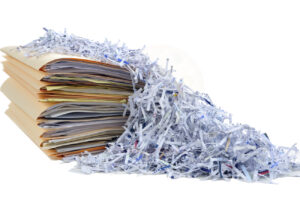
Let’s examine ways you can make sure you’re compliant during data destruction.
Do you remember when the most important piece of data you had to keep safe was the name of your crush? Perhaps we’re reaching too far into the past with that one, but it serves as a good analogy for how times have changed. In the past, the most sensitive data that most companies had about you (and had an obligation to safeguard) was your name and address and, perhaps, your social security number. These days, our lives exist as much in the digital universe as they do in reality, and the sheer amount of data that companies have about us is staggering. And also these days, companies have to work harder to protect that data against data breaches and thieves. This is just a sad reality of living in a digital age. Part of this process of protecting data is data destruction. Let’s examine ways you can make sure you’re compliant during data destruction.
What Is Data Destruction?
When we talk about data destruction, we are referring to the process of properly destroying the data that has been accumulated and stored. This can be either physical or digital copies of the data, but often it is both (especially if you use document digitization and a document automation system). The ways that this is achieved properly is controlled by set standards and industry best practices. Most people can picture how you might properly destroy physical data (shredding it and compiling it with multiple sources of other shredded materials so it can’t be put back together, for instance). Destroying digital data is both similar and different. Sensitive digital data must be overwritten with gibberish random data that makes it totally unreadable to be considered properly destroyed.
What Happens When It Isn’t Destroyed?
Properly destroying sensitive information is a crucial part of your business security processes.There are laws and regulations that regulate and control how you must properly destroy data, and this can vary from industry to industry. For instance, in healthcare, HIPPA controls how healthcare records are stored, accessed, and eventually destroyed when applicable. Paper records have to be completely shredded, pulverized, pulped, or burned and digital information has to be completely overwritten or magnetically cleared.In banking, data sharing has to be disclosed to consumers and data destruction is regulated by the FTC and the Fair and Accurate Credit Transactions Act stipulation.
How Can You Be In Compliance?
Being in compliance simply means following the laws or regulations that pertain to your industry. Make sure that you have a clear policy and everyone in your organization sticks to it. Make sure that your policy aligns with the laws that govern your industry. Finally, digitize as much as you can and store it securely so that you don’t have to maintain physical copies of everything.
Have Questions? Micro Records is Here to Help
If you have more questions about document management software, Micro Records is here to help you with all of your needs. We can help your business to transition to a paperless way of life with outstanding e-forms and technology. For more information about how we can help you implement your new document management software, visit us online or give us a call at 877-410-SCAN. For more tips, tricks, and to see what we have been working on, be sure to follow us on Facebook, Twitter, LinkedIn, and YouTube.
